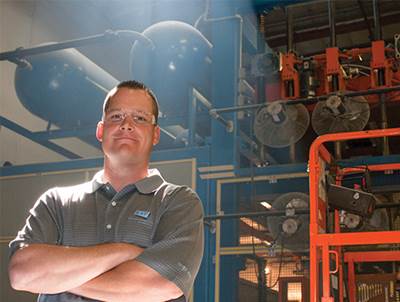Award-Winning Thermoformer: Ray Products Focuses on Pressure Forming for Crisp Aesthetics, Part-to-Part Repeatability
Ray Products’ pressure-forming expertise was recognized in the 2021 SPE Thermoforming Gold Award for its multi-part medical cart made with thermoplastics to replace cast urethane.
For Ray Products, it’s all about heavy-gauge thermoforming with pressure and vacuum. This focus helps explain why the Ontario, Calif., processor (rayplastics.com) received the 2021 SPE Thermoforming Gold award for pressure forming, using it to replace cast urethane with thermoplastics for a medical cart.
Ray is a 70-yr-old company that since 2003 has been headed up by Brian Ray, who serves as president and represents the third generation of family ownership. The company serves OEMs in medical devices, robotics and transportation, including electric-vehicle charging stations.
Says Jason Middleton, v.p. of sales and development, “We develop tight-tolerance, highly aesthetic enclosures and equipment by using state-of-the-art equipment like six-axis robotic CNC trimming centers and aluminum temperature-controlled tooling. Our pressure-forming process can deliver the quality, tolerances and aesthetics typically associated with injection molding at a lower tooling cost with faster turnaround times.”
He adds, “We have capabilities of not just thermoforming, but in-house painting and contract manufacturing, and are ISO 9001-2015 certified. We try and work with our customers very early in the project stages to provide DFM (Design for Manufacturing) feedback, and offer third-party design assistance if needed.”
Ray operates five rotary and single-station machines that provide pressure-forming capability up to 10 × 6 ft. and vacuum forming up to 10 × 18 ft., reportedly the largest vacuum forming machine on the West Coast. The company also has five six-axis robotic trimming centers.
To distinguish itself in the markets it serves, Ray Products uses its expertise to help customers identify new opportunities to use pressure forming to provide the most beneficial process for their needs. The company takes pride in never backing down from complex challenges and always looking to balance the total cost of manufacturing. When forming custom parts, Ray seeks to mold-in cosmetic and functional features, something it says not every thermoformer does, and often uses formed perimeter undercuts to add strength and rigidity.
The company boasts that the parts its pressure forms are so similar to molded parts that the most common question it is asked is, “Is this part injection molded?” At trade shows, Ray Products used its trademarked slogan, “This is NOT Injection Molding.” Says Middleton, “This motto pays tribute to the value we bring to the table, as our team can produce a part that not only mimics the aesthetics of an injection molded part, but one that comes at a fraction of the tooling cost and lead time.”
Ray Products dates back to the early 1950s and ’60s. It started with vacuum forming and fabrication but, in response to a demand from customers for improved part detail, added pressure-forming capabilities. The company has invested in new forming equipment that allows for consistent part detail and economical part production. Ray also takes pride in its in-house toolmakers , given the pivotal role tooling plays in the success of pressure-formed parts. The company aligns itself with high-quality sheet suppliers to ensure the best quality parts at competitive prices.
The company boasts that the results of pressure forming and molding can be so similar that the most common question they hear is, “Is this part injection molded.”
Award-Winning Medical Cart
The part that was acknowledged in the SPE contest includes 12 highly aesthetic pressure-formed parts. The assembly includes 10 parts molded in color and two painted parts. The cart was originally manufactured from cast urethane, but pressure forming was able to improve part-to-part repeatability and aesthetics without impacting the overall cart design.

The 12 pressure-formed parts of this medical cart have no outside attachments, and undercut features are used to secure the side panels. When the side panels are closed, other parts in the assembly overlap to hide any additional attachment hardware. (All photos: Ray Products)
When made by urethane casting, this cart required painting every part and limited the production quantities to 25 pieces at a time. The urethane parts also required 100% inspection using a full assembly check fixture, and approved parts were kitted and shipped together as a unique set. Notes Middleton, “It is not repeatable manufacturing if you must keep a set of parts together as unique sets.”
Says Middleton, “Because the urethane process required the customer to purchase complete kits of parts, the customer was always purchasing 25 kits of 12 parts. The customer needed to keep each kit together, with no flexibility of individual parts being interchanged. Urethane, when soft tooled, requires a new tool every 25 pieces, and typically a new master tool every 75 pieces. This is another reason they could only get 25 pieces of each part number at a time.”
“It is not repeatable manufacturing if you must keep a set of parts together as unique sets.”
The Switch to Pressure Forming
After switching to pressure forming using color-matched acrylic/PVC sheet in thicknesses of 0.187 and 0.250 in., with some parts in metallic color, the medical-device OEM was able to significantly reduce total project costs, improve its manufacturing speed, increase part durability, and guarantee part-to-part repeatability without the need of unique part sets.
Explains Middleton, “The urethane parts were not interchangeable, meaning a set of 12 urethane parts needed to stay together and follow the specific chassis until it was completed and ready for shipment by the customer. It was not uncommon for the customer to experience part-to-part fit issues with the urethane parts at different times throughout the assembly process, which would require them to stop the build process on the specific unit, and move to a new unit with a new set of skins. The customer would be required to rework parts on the line in order to keep their production moving.
“The repeatable pressure-formed parts produced by Ray Products are received by the customer as individual part numbers, pulled from stock and assembled as required by our customer.”
Asked how they came to select the acrylic/PVC sheet for this project, Middleton notes that because the application was a medical cart, they wanted a material that provided superior impact and chemical resistance and was available in lower volumes to support the transition from urethane to pressure forming. Kydex T and Kydex110 sheet extruded by Sekisui Polymer Innovations met the criteria.
Moreover, the switch to color-matched material—including a metallic finish—reduced the total project cost by over 25% when factoring in paint and prep cost, as well as the reduction in finished-part lead time and cosmetic rejects, according to Middleton.
Also, Ray Products was able to increase part durability. Says Middleton, “By utilizing molded-in color options, we eliminated the chipping and scratching of the paint that was problematic with the urethane parts.”
Part-to-part repeatability ensures that a customer can order individual parts whenever they require. Pressure-formed parts are interchangeable, meaning a part number that is ordered today can replace the exact part number that was produced last month, last year or even in the last decade. Parts often get damaged in the field, and Middleton says, “It is crucial that our customers have the confidence that those parts can easily be reproduced to the same tolerances and specifications as all the parts that have been produced previously.”

Multiple pressure-formed parts mate to each other with consistent reveal lines. The blue parts are formed in a precolored metallic material and gray parts are also molded-in color.
The pressure-forming process and use of various molded-in features, including several undercuts, allowed Ray Products to significantly reduce the number of purchased components in the assembly.
Says Middleton, “Typically, with medical carts, we work closely with the customer to understand the order of part assembly and the potential field-service requirements and access points. Once we start the design review, we look at all mating surfaces and additional processes that are being utilized. We want to understand all interfaces, whether plastic-to-plastic or plastic-to-sheet-metal. Once we understand how the assembly goes together, we focus on part edges and utilize undercuts to add strength and structure while improving cosmetics by keeping only molded edges visible.”
Middleton adds that tight tolerances and aesthetics are required by most of their medical customers, which typically means that all fasteners and attachment points need to be hidden. “Since the unit we converted from urethane to pressure forming was already in production, we were not able to change the existing sheet-metal frame, which required us to get creative with attachment points. The pressure-formed parts have no outside attachments, and we use undercut features to secure the side panels. When the side panels are closed, other parts in the assembly overlap to hide any additional attachment hardware. This was done on multiple parts to achieve the same results across the cart. We were able to use the existing sheet-metal frame with minimal modifications, allowing the customer to make a smooth transition from urethane to pressure forming.”
Middleton explains that one of the biggest customer complaints on this unit had been part inconsistency, which created various gaps on the assembled units and some parts would not mount correctly. “We utilized various starting gauges for all of these parts that are mated. We have multiple pressure-formed parts that are mating to each other with consistent reveal lines.”
He continues, “Even with the different material thicknesses, you can see that all outside mating edges line up. This is a key attribute of pressure forming, as well as the ability to hold tight tolerances.”
Middleton adds that with six-axis robotic trimming, Ray is able to minimize or eliminate visibility of trimmed surfaces. The formed undercuts allow Ray to create features like grooves, slots and snap fits that improved the overall cart assembly. In addition, these undercut features allow Ray to eliminate bonded bosses and sheet-metal sections, thus decreasing assembly time and part cost.
The pressure-forming process provided the customer with a total return on investment within the first 50 units produced, and there were no issues about meeting current and future customer demand.
Related Content
Use Cavity Pressure Measurement to Simplify GMP-Compliant Medical Molding
Cavity-pressure monitoring describes precisely what’s taking place inside the mold, providing a transparent view of the conditions under which a part is created and ensuring conformance with GMP and ISO 13485 in medical injection molding.
Read MoreConsistent Shots for Consistent Shots
An integral supplier in the effort to fast-track COVID-19 vaccine deployment, Retractable Technologies turned to Arburg and its PressurePilot technology to help deliver more than 500 million syringes during the pandemic.
Read MoreKrones Acquires Netstal
Krones adds PET preform injection molding to its bottle blowing and filling capabilities, as well as cap molding and expansion into medical, food and other markets.
Read MorePlastic Compounding Market to Outpace Metal & Alloy Market Growth
Study shows the plastic compounding process is being used to boost electrical properties and UV resistance while custom compounding is increasingly being used to achieve high-performance in plastic-based goods.
Read MoreRead Next
Custom Thermoformer Relies On Robotic Trimming
Fully robotic, six-axis trimming has improved speed and quality while cutting costs for this former.
Read MoreSPE Names Winners of Thermoforming Parts Competition
Creative boundaries pushed in each category, SPE says.
Read MoreLead the Conversation, Change the Conversation
Coverage of single-use plastics can be both misleading and demoralizing. Here are 10 tips for changing the perception of the plastics industry at your company and in your community.
Read More






























